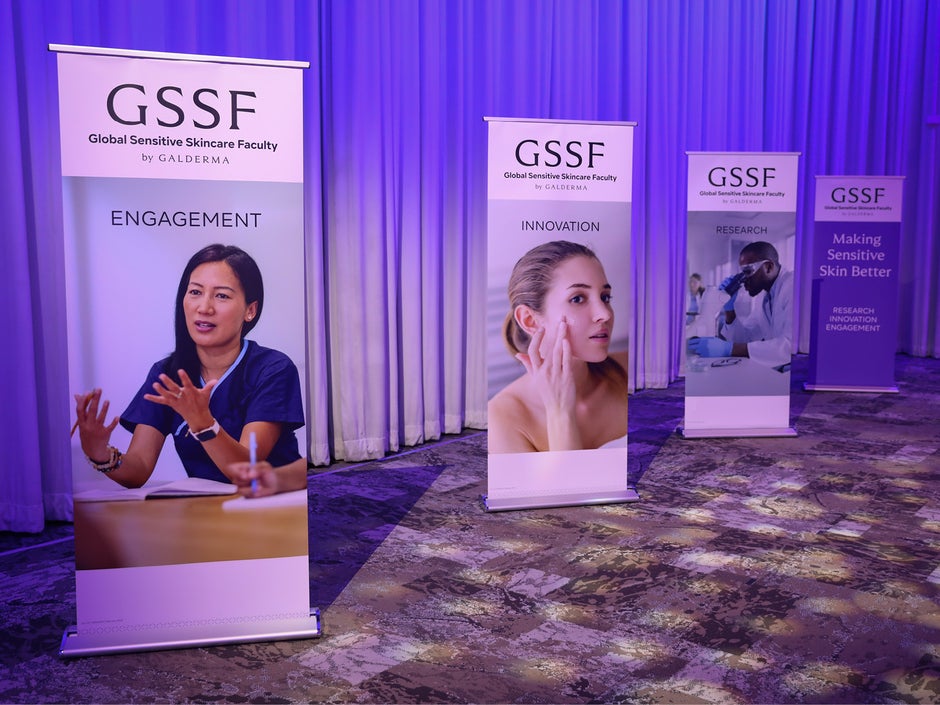
Sensitive skin is an exceedingly common condition that has an impact on the physical and mental well-being of millions of people worldwide, with symptoms ranging from dryness to discomfort and redness. Yet this condition remains widely overlooked and under studied: less than 30% of U.S. dermatology residents consider themselves knowledgeable on sensitive skin. This educational gap stands as a severe barrier to diagnosis and product options for relief for the 70% of individuals worldwide with skin sensitivity.
As part of Galderma’s purpose of advancing dermatology for every skin story, we are committed to raising awareness around this condition. Learn how the Global Sensitive Skincare Faculty (GSSF) is taking concrete steps to transform understanding and promote inclusivity for all individuals with sensitive skin.
Inclusive research creates actionable and generalizable outcomes
The only way to make a significant impact or change in the dermatology landscape is to start simple yet holistic; taking everyone’s needs, every story, into account. And when it comes to a condition as complex as sensitive skin, which has a complex, unique, but still incomplete pathophysiology and clinical classification, developing purposeful solutions first requires comprehensive and inclusive characterization.
This approach has become increasingly integral to the GSSF, our worldwide network of experts striving to set new industry standards of care. By building on three pillars—research, innovation, and engagement—the faculty aims to offer actionable insights to healthcare professionals and positively impact the future of product development.
Given the breadth and scope of this condition, the GSSF, central to its mission, is prioritizing an inclusive approach to both data generation and patient recruitment. As faculty members share, representing a range of geographies and skin types is of crucial importance when it comes to developing targeted skincare strategies: “You can’t paint people with a broad brush,” says Professor Ncoza Dlova, Head of Dermatology at the University of KwaZulu-Natal in Durban, South Africa. “There are different skin types, as well as a range of epigenetic and climate-based factors that impact sensitive skin.”
This outlook led the GSSF to expand the scope of their research demographic in recent years. In 2023, they initiated an extensive global epidemiological survey involving more than 16,000 subjects, including individuals of African, Asian and South American descent. As a result, 50% of study subjects identified as non-Caucasian, compared to 26% in 2021. “When we’re defining a condition, we must understand its burden across demographics,” says Professor Adam Friedman, GSSF Co-Chair and Chair of Dermatology at The George Washington University, USA.
Sharing groundbreaking insights with a world-class audience
Sharing knowledge and learnings from the research pillar is an integral part of the GSSF’s mission, and the faculty regularly exchanges expertise with the wider dermatology community at global educational events. For example, at the GSSF Educational Forum in March 2025, in Orlando, United States, faculty members unveiled new data on the mechanisms of sensitive skin based on unique and demographic specific findings, for example that for someone who has sensitive skin, the darker the skin tone the greater likelihood for more severe sensitive skin.
Diving even deeper, an evaluation of the structural changes in the skin of those with and without sensitive skin was performed and findings shared in international forums spanning from Berlin to Singapore. By comparing and measuring differences in the skin barrier thickness, collagen quality and vascularization of patients with sensitive and non-sensitive skin, they succeeded in identifying sensitive skin as a standalone condition with its own unique dysfunctional patterns. “We were also able to perceive that sensitive skin ages at a faster rate,” says Professor Giovanni Pellacani, Chairman of Dermatology at La Sapienza University of Rome, Italy, and GSSF faculty member. “This clinical perception can help us to better improve the quality of skin of patients, for example by keeping their skin more moisturized and protected.”
At the same event, Professor Friedman presented a GSSF-supported study on atopic dermatitis, recently published in the Journal of Drugs and Dermatology. This research focused on an imbalance of bacteria on the skin surface found in and to be a driver of conditions such as eczema, known as dysbiosis. “What we found was that a Cetaphil® moisturizer can help restore the essential diversity of the bacteria that live on the skin, which helps to maintain the skin barrier and regulate inflammation,” he says. “This ultimately translates to healthier skin.”
A commitment to sensitive skin patients everywhere
As Galderma strives to bring more solutions to those struggling with sensitive skin, networks such as the GSSF play a critical role in transforming the field of dermatology. “We are very proud to promote inclusion within our everyday research,” says Dr. Krzysztof Piotrowski, GSSF Co-Chair and Global Head of Medical, Dermatological Skincare at Galderma. “This expansion will ultimately enable us to bring more innovative products and ways of management to people with sensitive skin.”
By fostering education, establishing means of diagnosis and diversifying their research, the faculty is helping to bring more solutions to support patients across the world. These milestones speak to the mission at the core of the GSSF and Galderma: creating better lives for individuals across the entire spectrum of dermatology.